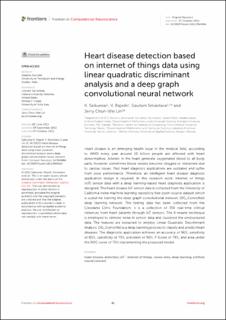| dc.contributor.author | Saikumar, K. | |
| dc.contributor.author | Rajesh, V. | |
| dc.contributor.author | Srivastava, Gautam | |
| dc.contributor.author | Lin, Jerry Chun-Wei | |
| dc.date.accessioned | 2023-03-23T11:46:30Z | |
| dc.date.available | 2023-03-23T11:46:30Z | |
| dc.date.created | 2022-11-03T14:51:48Z | |
| dc.date.issued | 2022 | |
| dc.identifier.citation | Frontiers in Computational Neuroscience. 2022, 16:964686. | en_US |
| dc.identifier.issn | 1662-5188 | |
| dc.identifier.uri | https://hdl.handle.net/11250/3060100 | |
| dc.description.abstract | Heart disease is an emerging health issue in the medical field, according to WHO every year around 10 billion people are affected with heart abnormalities. Arteries in the heart generate oxygenated blood to all body parts, however sometimes blood vessels become clogged or restrained due to cardiac issues. Past heart diagnosis applications are outdated and suffer from poor performance. Therefore, an intelligent heart disease diagnosis application design is required. In this research work, internet of things (IoT) sensor data with a deep learning-based heart diagnosis application is designed. The heart disease IoT sensor data is collected from the University of California Irvine machine learning repository free open-source dataset which is useful for training the deep graph convolutional network (DG_ConvoNet) deep learning network. The testing data has been collected from the Cleveland Clinic Foundation; it is a collection of 350 real-time clinical instances from heart patients through IoT sensors. The K-means technique is employed to remove noise in sensor data and clustered the unstructured data. The features are extracted to employ Linear Quadratic Discriminant Analysis. DG_ConvoNet is a deep learning process to classify and predict heart diseases. The diagnostic application achieves an accuracy of 96%, sensitivity of 80%, specificity of 73%, precision of 90%, F-Score of 79%, and area under the ROC curve of 75% implementing the proposed model. | en_US |
| dc.language.iso | eng | en_US |
| dc.publisher | Frontiers Media | en_US |
| dc.rights | Navngivelse 4.0 Internasjonal | * |
| dc.rights.uri | http://creativecommons.org/licenses/by/4.0/deed.no | * |
| dc.title | Heart disease detection based on internet of things data using linear quadratic discriminant analysis and a deep graph convolutional neural network | en_US |
| dc.type | Peer reviewed | en_US |
| dc.type | Journal article | en_US |
| dc.description.version | publishedVersion | en_US |
| dc.rights.holder | © 2022 Saikumar, Rajesh, Srivastava and Lin. | en_US |
| dc.source.volume | 16 | en_US |
| dc.source.journal | Frontiers in Computational Neuroscience | en_US |
| dc.identifier.doi | 10.3389/fncom.2022.964686 | |
| dc.identifier.cristin | 2068735 | |
| dc.source.articlenumber | 964686 | en_US |
| cristin.ispublished | true | |
| cristin.fulltext | original | |
| cristin.qualitycode | 1 | |

